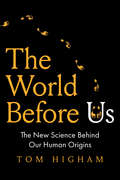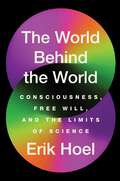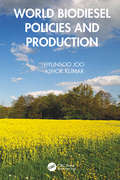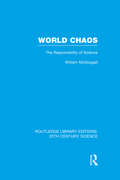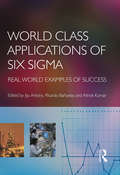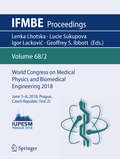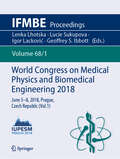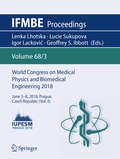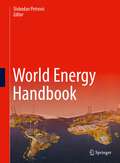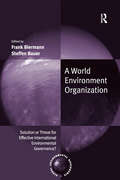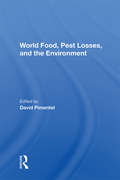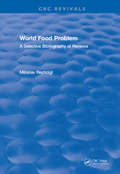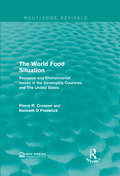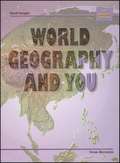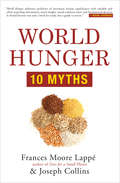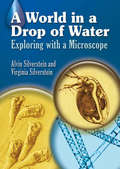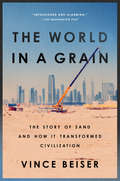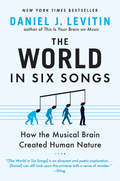- Table View
- List View
The World Before Us: The New Science Behind Our Human Origins
by Tom HighamA fascinating investigation of the origin of humans based on incredible new discoveries and advanced scientific technology Fifty thousand years ago, Homo sapiens was not the only species of humans in the world. There were also Neanderthals in what is now Europe, the Near East, and parts of Eurasia; Hobbits (H. floresiensis) on the island of Flores in Indonesia; Denisovans in Siberia and eastern Eurasia; and H. luzonensis in the Philippines. Tom Higham investigates what we know about these other human species and explores what can be learned from the genetic links between them and us. He also looks at whether H. erectus may have survived into the period when our ancestors first moved into Southeast Asia. Filled with thrilling tales of recent scientific discoveries, this book offers an engaging synopsis of our current understanding of human origins and raises new and interesting possibilities—particularly concerning what contact, if any, these other species might have had with us prior to their extinction.
The World Behind the World: Consciousness, Free Will, and the Limits of Science
by Erik HoelA fascinating exploration into how the brain creates our conscious experiences—potentially revolutionizing neuroscience and the future of technology—from a Forbes 30 Under 30 scientist.Throughout history, two perspectives on the world have dueled in our minds: the extrinsic—that of mechanism and physics—and the intrinsic—that of feelings, thoughts, and ideas. The intrinsic perspective allows us to tell stories about our lives, to chart our anger and our lust, to understand our psychologies. The extrinsic allows us to chart the physical world, to build upon it, and to travel across it. These perspectives have never been reconciled; they almost seem to exist on different planes of thought. Only recently, due to the pioneering work of DNA-discoverer Francis Crick, have these two perspectives been conjoined. This attempt to reconcile these perspectives is the science of consciousness, and posits that the intrinsic aspect of the world, how and what we perceive, can coexist in the extrinsic part of the world, in the realm of physics. The World Behind the World is a grand tour of the state of this science, an exploration of the point where tectonic metaphysical forces meet, often in paradoxical conclusions. Forbes 30 Under 30 scientist Dr. Erik Hoel lays out the evidence that nothing in the brain makes sense except in the light of a theory of consciousness. Some topics he examines include what the similarities are between our brains and black holes; where consciousness fits into physics and morality; and why it may be impossible for AI to ever become conscious, despite popular belief. The World Behind the World argues that establishing a proven theory of consciousness would trigger a paradigm shift in the field of neuroscience and the future of technology—transforming the very fabric of our society. What does the science of consciousness tell us about what happens beyond brain death? Does our understanding of consciousness strengthen or weaken the case for free will? Is science itself incomplete in the way Gödel showed mathematics is? By taking us through the heated debates of the field and drawing on Hoel&’s own original research to shed light on the latest theories about how the brain creates consciousness, The World Behind the World shows us that at long last, science is coming to understand the fundamental mystery of human existence.
World Biodiesel Policies and Production
by Hyunsoo Joo Ashok KumarThis book presents the evolution of biodiesel technologies along with government policies of major biodiesel producing countries with their backgrounds, impacts, changes, and other energy forms. Biodiesel feedstock and biodiesel production technologies including green algae and methanol are presented as separate topics. Changes in the feedstock types and the corresponding technologies are presented, and their impacts on the biodiesel policies are explained. The life cycle analysis (LCA) in research and policy design of biodiesel is discussed and the findings are given for different feedstocks in terms of greenhouse gases, energy, and other impact categories.
World Chaos: The Responsibility of Science (Routledge Library Editions: 20th Century Science)
by William McDougallThis book, first published 1931, examines the attitudes surrounding the natural sciences at the time of writing, and contends that an unreflective belief in the power of science, and especially in humanity’s capacity to turn such knowledge to noble ends, could lead to catastrophic results for human civilisation. Commenting on the forced industrialisation in Russia, India and China that was proceeding with little regard for human life at the time, the unsustainable inequality generated by modern Western capitalism and many other related issues, the author argues that it is necessary to devote the same energy to the resolution of social problems as to scientific research and development. His thesis, though expounded with reference to concrete situation different from our own, is nonetheless as relevant today as it was when first published.
World Class Applications of Six Sigma
by Ashok Kumar Jiju Antony Ricardo BañuelasWorld Class Applications shows what real organisations have done to implement Six Sigma, the methodology used, and the results delivered. The book provides details of how these organisations overcame issues with the statistical tools of Six Sigma and provides valuable lessons by explaining what went wrong when implementation failed. Cases cover topics including: Six Sigma in HR; Implementing Six Sigma in the Dow Chemical company; Six Sigma in IT; and Six Sigma to improve reporting quality.
World Congress on Medical Physics and Biomedical Engineering 2018: June 3-8, 2018, Prague, Czech Republic (vol. 2) (IFMBE Proceedings #68/2)
by Geoffrey S. Ibbott Lenka Lhotska Lucie Sukupova Igor LackovićThis book (vol. 2) presents the proceedings of the IUPESM World Congress on Biomedical Engineering and Medical Physics, a triennially organized joint meeting of medical physicists, biomedical engineers and adjoining health care professionals. Besides the purely scientific and technological topics, the 2018 Congress will also focus on other aspects of professional involvement in health care, such as education and training, accreditation and certification, health technology assessment and patient safety. The IUPESM meeting is an important forum for medical physicists and biomedical engineers in medicine and healthcare learn and share knowledge, and discuss the latest research outcomes and technological advancements as well as new ideas in both medical physics and biomedical engineering field.
World Congress on Medical Physics and Biomedical Engineering 2018: June 3-8, 2018, Prague, Czech Republic (vol. 2) (IFMBE Proceedings #68/2)
by Geoffrey S. Ibbott Lenka Lhotska Lucie Sukupova Igor LackovićThis book (vol. 1) presents the proceedings of the IUPESM World Congress on Biomedical Engineering and Medical Physics, a triennially organized joint meeting of medical physicists, biomedical engineers and adjoining health care professionals. Besides the purely scientific and technological topics, the 2018 Congress will also focus on other aspects of professional involvement in health care, such as education and training, accreditation and certification, health technology assessment and patient safety. The IUPESM meeting is an important forum for medical physicists and biomedical engineers in medicine and healthcare learn and share knowledge, and discuss the latest research outcomes and technological advancements as well as new ideas in both medical physics and biomedical engineering field.
World Congress on Medical Physics and Biomedical Engineering 2018: June 3-8, 2018, Prague, Czech Republic (vol. 2) (IFMBE Proceedings #68/2)
by Lenka Lhotska Lucie Sukupova Igor Lacković Geoffrey S. IbbottThis book (vol. 3) presents the proceedings of the IUPESM World Congress on Biomedical Engineering and Medical Physics, a triennially organized joint meeting of medical physicists, biomedical engineers and adjoining health care professionals. Besides the purely scientific and technological topics, the 2018 Congress will also focus on other aspects of professional involvement in health care, such as education and training, accreditation and certification, health technology assessment and patient safety. The IUPESM meeting is an important forum for medical physicists and biomedical engineers in medicine and healthcare learn and share knowledge, and discuss the latest research outcomes and technological advancements as well as new ideas in both medical physics and biomedical engineering field.
World Cultures and Geography
by Sarah Witham Bednarz Ines M. Miyares Mark C. Schug Charles S. WhiteThis textbook contains unit lessons on Introduction to World Cultures and Geography, The United States and Canada, Latin America, Europe, Russia, and the Independent Republics, North Africa and Southwest Asia, Africa South of the Sahara, Southern Asia, East Asia, Australia, Oceania, and Antarctica. The book includes the biographies of nineteen eminent personalities.
World Energy Handbook
by Slobodan PetrovicWorld Energy Handbook presents an overview of the energy systems of selected countries in Africa, Asia, the Americas, and Europe. It is a complete guide to energy history and generation in these countries, including renewable energy, storage, and use. The authors follow the same analytical approach for each country to construct comprehensive surveys of all aspects of energy systems, examining the advantages and disadvantages of each country’s energy infrastructures. The handbook aims to raise awareness about the condition and deficiencies of energy systems in developing countries, and the potential for the countries to improve, grow, and advance the technologies for energy generation – especially by turning to renewable energy sources to increase energy storage capacities and optimizing the way subsystems are integrated. The book serves as a must-have guide for decision-makers, investors, business people, and other professionals to understand the global distribution of energy generation, transmission, and each country’s carbon footprint and identify opportunities for energy system improvement worldwide.
A World Environment Organization: Solution or Threat for Effective International Environmental Governance? (Global Environmental Governance)
by Frank BiermannIn recent years, the debate on the establishment of a new international agency on environmental protection - a 'World Environment Organization' - has gained substantial momentum. Several countries, including France and Germany, as well as a number of leading experts and senior international civil servants have openly supported the creation of such a new international organization. However, a number of critics have also taken the floor and brought forward important objections. This book presents a balanced selection of articles of the leading participants in this debate, including both major supporters and opponents of creating a World Environment Organization. The volume is especially relevant to students and scholars of international relations, environmental policy and international law, as well as to practitioners of diplomacy, international negotiations, and environmental policy making.
World Explorer: Tools and Concepts
by Heidi Hayes Jacobs Michal L. LevasseurLearning about geography tools and concepts means being an explorer, and no explorer would start out without first checking some facts. Use the activities on the following page to begin exploring the world of geography. They will help you learn what geography is and how it can help you.
World Food, Pest Losses, And The Environment
by David PimentelThis book focuses on current food shortages and on the impact of pests in reducing world food supplies. At present, total worldwide food losses from pests are estimated to be about 45 percent. Preharvest losses alone, from insects, plant pathogens, and weeds, are estimated at about 30 percent. Additional postharvest losses from microorganisms, insects, and rodents range from about 10 to 20 percent. The contributors present data on the extent of these kinds of crop losses and analyze immediate and long-term pest management strategies. Emphasis is given to an evaluation of the effectiveness of integrated controls and the various new nonchemical pest controls used to reduce crop and livestock losses. The current worldwide environmental problems associated with both large-scale pesticide use and other pest control methods are also analyzed, including the impact that increased use of pesticides can be expected to have on the human environment. While the data included are technical, the presentation and analysis will be of interest to both the scientific community and the general public.
World Food Problem
by Professor Miloslav RechciglThe aim of this publication is to provide the interested reader with an authoritative and comprehensive up-to-date bibliography on all important facets of the world food problem, encompassing such questions as the availability of natural reseources, the present and future sources of energy, environmental quality, population growth, world malnutrition, the state of food production, food consumption patterns, future food needs, toxicological aspects of food, agricultural and industrial aspects of food production, and family planning. It is the first compilation of its kind in that it covers the subject from a multidisciplinary point of view, including publications that deal with teh description and alaysis of the world food problem as well as those that offer alternative strategies adn specific technological meaures for alleviating the problem.
The World Food Situation: Resource and Environmental Issues in the Developing Countries and The United States (Routledge Revivals)
by Pierre R. Crosson Kenneth D FrederickAt the beginning of the 1970’s, global grain reserves were level and food prices were low however as the decade progressed crop production plummeted leading to a food crisis. Originally published in the aftermath in 1977, Crosson and Frederick set out to explore the ability of agricultural output to meet the global food demands of future generations. This study analyses how resources and environmental factors would affect food production in developing countries and the United States until the end of the 21st Century. The environmental impacts of land levels, fertiliser and pesticide use are explored in relation to the challenges of meeting food demands. This title will be of interest to students of environmental studies.
World Geography: Building a Global Perspective
by Thomas J. Baerwald Celeste FraserThis program will help you learn content, develop skills, and apply what you know. Examine these pages to understand how this textbook and its online resources can guide you through the study of world geography.
World Geography
by Preston E. James Nelda DavisGo on a geographical tour around the world! Explore the world while solving the riddle using informational clues about each country. Students study 30 countries, grouped by continent, using maps, charts, graphs, puzzles, and hands-on activities.
World Geography and You: The Complete Edition
by Vivian BernsteinAs you study world geography, you will learn what the land looks like in different parts of the world. You will learn how people live in different places. You will study how people have changed the places where they live. You will also study the culture of people in different countries. Culture is the ideas, art, and way of life of a group of people. When you study about culture, you learn about food, clothing, sports, customs, and language of a group of people. Religion is also part of culture. Religion is the different ways people believe and pray to a god or to many gods.
World Geography (California Edition)
by Daniel D. Arreola Marci Smith Deal James F. Petersen Rickie SandersThis McDougal Littell California Edition of World Geography consists of reading materials on The Basics of Geography, The United States and Canada, Latin America, Europe, Russia and the Republics, Africa, Southwest Asia, South Asia, East Asia, Southeast Asia, Oceania, and Antarctica, etc.
World Geography Today
by David M. HelgrenWorld Geography Today is a guide to learning about the constantly changing world in which you live. This textbook will help you understand the study of geography and make sense of our complex world.
World Hunger: 10 Myths
by Joseph Collins Frances Moore LappéFrom bestselling authors Frances Moore Lappé and Joseph Collins comes the 21st century’s definitive book on world hunger. Driven by the question, "Why hunger despite an abundance of food?" Lappé and Collins refute the myths that prevent us from addressing the root causes of hunger across the globe. World Hunger: Ten Myths draws on extensive new research to offer fresh, often startling, insights about tough questions-from climate change and population growth to genetically modified organisms (GMOs) and the role of U.S. foreign aid, and more.Brimming with little-known but life-changing examples of solutions to hunger worldwide, this myth-busting book argues that sustainable agriculture can feed the world, that we can end nutritional deprivation affecting one-quarter of the world’s people, and that most in the Global North have more in common with hungry people than they thought. For novices and scholars alike, World Hunger: Ten Myths will inspire a whole new generation of hunger-fighters.
A World in a Drop of Water: Exploring with a Microscope (Dover Children's Science Books)
by Alvin Silverstein Virginia SilversteinThis inexpensive volume showcases an array of curious creatures: a blob-like amoeba; a slipper-shaped paramecium and its mortal enemy, the suctorian; and many others. The authors recount the feeding, reproductive, and defensive strategies employed by these animals in easy-to-understand language that opens the door to a wonderful world of discovery. 37 illustrations.
The World in a Grain: The Story of Sand and How It Transformed Civilization
by Vince BeiserThe gripping story of the most important overlooked commodity in the world--sand--and the crucial role it plays in our lives.After water and air, sand is the natural resource that we consume more than any other--even more than oil. Every concrete building and paved road on Earth, every computer screen and silicon chip, is made from sand. From Egypt's pyramids to the Hubble telescope, from the world's tallest skyscraper to the sidewalk below it, from Chartres' stained-glass windows to your iPhone, sand shelters us, empowers us, engages us, and inspires us. It's the ingredient that makes possible our cities, our science, our lives--and our future.And, incredibly, we're running out of it.The World in a Grain is the compelling true story of the hugely important and diminishing natural resource that grows more essential every day, and of the people who mine it, sell it, build with it--and sometimes, even kill for it. It's also a provocative examination of the serious human and environmental costs incurred by our dependence on sand, which has received little public attention. Not all sand is created equal: Some of the easiest sand to get to is the least useful. Award-winning journalist Vince Beiser delves deep into this world, taking readers on a journey across the globe, from the United States to remote corners of India, China, and Dubai to explain why sand is so crucial to modern life. Along the way, readers encounter world-changing innovators, island-building entrepreneurs, desert fighters, and murderous sand pirates. The result is an entertaining and eye-opening work, one that is both unexpected and involving, rippling with fascinating detail and filled with surprising characters.
The World in Six Songs: How the Musical Brain Created Human Nature
by Daniel J. LevitinThe author of the New York Times bestseller This Is Your Brain on Music reveals music's role in the evolution of human culture-and "will leave you awestruck" (The New York Times)Daniel J. Levitin's astounding debut bestseller, This Is Your Brain on Music, enthralled and delighted readers as it transformed our understanding of how music gets in our heads and stays there. Now in his second New York Times bestseller, his genius for combining science and art reveals how music shaped humanity across cultures and throughout history. Dr. Levitin identifies six fundamental song functions or types-friendship, joy, comfort, religion, knowledge, and love-then shows how each in its own way has enabled the social bonding necessary for human culture and society to evolve. He shows, in effect, how these "six songs" work in our brains to preserve the emotional history of our lives and species. Dr. Levitin combines cutting-edge scientific research from his music cognition lab at McGill University and work in an array of related fields; his own sometimes hilarious experiences in the music business; and illuminating interviews with musicians such as Sting and David Byrne, as well as conductors, anthropologists, and evolutionary biologists. The World in Six Songs is, ultimately, a revolution in our understanding of how human nature evolved-right up to the iPod.Read Daniel Levitin's posts on the Penguin Blog.
The World in Six Songs: How the Musical Brain Created Human Nature
by Daniel J. LevitinThe author of the New York Times bestseller This Is Your Brain on Music reveals music's role in the evolution of human culture-and "will leave you awestruck" (The New York Times)Daniel J. Levitin's astounding debut bestseller, This Is Your Brain on Music, enthralled and delighted readers as it transformed our understanding of how music gets in our heads and stays there. Now in his second New York Times bestseller, his genius for combining science and art reveals how music shaped humanity across cultures and throughout history. Dr. Levitin identifies six fundamental song functions or types-friendship, joy, comfort, religion, knowledge, and love-then shows how each in its own way has enabled the social bonding necessary for human culture and society to evolve. He shows, in effect, how these "six songs" work in our brains to preserve the emotional history of our lives and species. Dr. Levitin combines cutting-edge scientific research from his music cognition lab at McGill University and work in an array of related fields; his own sometimes hilarious experiences in the music business; and illuminating interviews with musicians such as Sting and David Byrne, as well as conductors, anthropologists, and evolutionary biologists. The World in Six Songs is, ultimately, a revolution in our understanding of how human nature evolved-right up to the iPod.Read Daniel Levitin's posts on the Penguin Blog.
